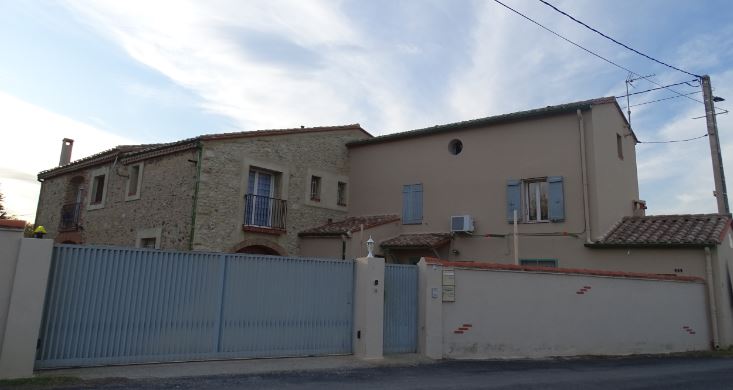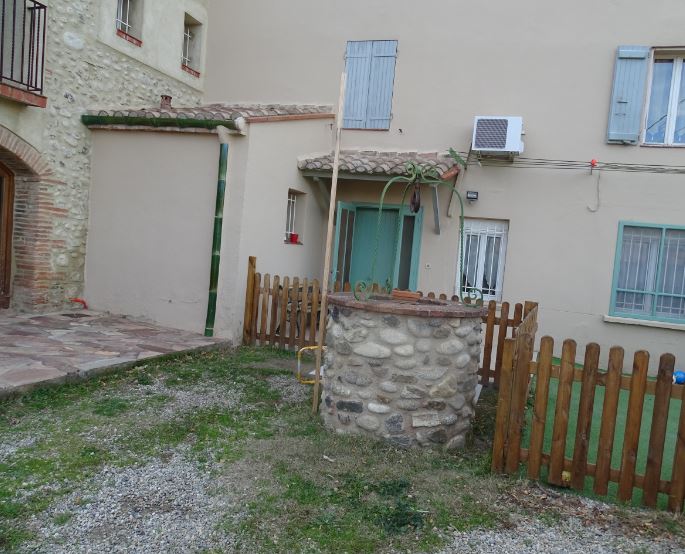
Watercolour 20b
Blanc Ontoine

1925
39.1 x 50.6 cm
The Hunterian, University of Glasgow


During their second stay in Roussillon from November 1924 to May 1925, Charles Rennie Mackintosh and his wife Margaret stayed in Ille-sur-Têt. They stayed in a small, comfortable, but simple and inexpensive hotel: “Hotel du Midi” on RN27.
The building still exists today and has become a café pizzeria: the building has remained unchanged with its rockwork balconies (a composition of cement mortar that imitates nature like the trunks of trees. These dreamlike, baroque creations became popular in the 19th century).
Four watercolours by Charles Rennie Mackintosh bear witness to this visit to the region, including one entitled “Mas Blanc Ontoine”.
The watercolour depicts a mas (farmhouse), one of Charles Rennie Mackintosh’s favourite subjects.
The farmhouse occupies the entire centre of the canvas in pastel ochre, a brown tiled roof with grey cast shadows. The farmhouse consists of a dwelling house with a barn behind it.
In front of the farmhouse, an area of short green grass occupies the foreground of the watercolour, various trees surround the buildings, a well is clearly visible near the house. Above the building, a pastel blue sky is streaked with white cirrus clouds. To the right of the farmhouse, on the horizon, one can see grey mountains.
Charles Rennie Mackintosh positioned himself on the ground in front of the farmhouse, looking westwards (east side of the house) to create the work.
Location
Mas Blanc- Ontoine is located in the south of Ille-sur-Têt, about 15 minutes from the hotel, at the intersection of the old road from Ille-sur-Têt to Bouleternère and the Cami del Mas Blanc (dead end).
The Mas is located on the right side of a small railway line, in the direction of Perpignan/Villefranche de Conflent, and its main façade overlooks a level crossing. This mas still exists and is very recognizable. The barn has been converted into a house. The whole has been carefully restored.
However, the environment of the farmhouse has changed: a wall has recently been built all around the property which is accessed through a large metal gate. A garden has been laid out and the well, although modified, still exists.
Pictorial analysis
- Blanc Ontoine is a small farm near Ille-sur-Têt, known as Mas Blanc. It is situated on what was in the 1970s the main road to Bouleternère. The bare tree in the foreground and the winter foliage behind suggest that the work was painted early in the year. The farmhouse has since been modernised but is still recognisable. The sky is treated more expressively than in most of Mackintosh’s watercolours and is reminiscent of ‘A Hill Town in Southern France’. Professor Pamela Robertson – University of Glasgow – S.Plas with kind permission of the author
This watercolour shows a group of buildings whose appearance has changed little. Mackintosh, whose training as an architect emphasises volume, has chosen the right viewpoint and lighting and gives us access to the motif through a broad foreground.
The palette is sober, more value-oriented than colour-oriented.
The different surfaces that animate the sky are integrated with great accuracy into the whole.
Itinerary for the farmhouse
NB: The chair supporting this work is not located here but is situated in Ille-sur-têt near the Hôtel du Midi at the intersection of the Rue des Pommiers and the Route Nationale.